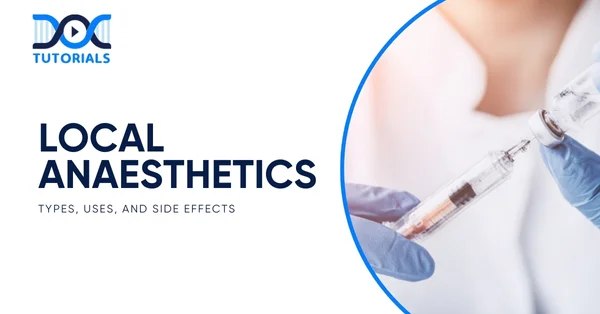Local Anaesthetics: Types, Uses, and Side Effects

Local anaesthetics are a group of anaesthesia medications that are commonly applied in medicine and dentistry to prevent pain in certain parts of the body. These anaesthetics function by inhibiting the transmission of nerve impulses to the brain, essentially preventing pain at its origin.
Understanding the types, uses, and side effects of local anaesthesia drugs is important for any NEET PG aspirant, as they are high-yield pharmacology topics. Let’s explore the types, clinical applications, and complications of local anaesthesia.
Keep reading!
What are Local Anaesthetic Drugs?
Local anaesthetic drugs are the medications employed to transiently suppress sensation, such as pain, in a localised body region without inducing loss of consciousness. They act by inhibiting the nerve impulses at peripheral nerves.
They are often employed preoperatively or pre-dentally for minor surgical or dental procedures and can also be used to cure post-operative or chronic pain. Based on the site of action, they can also suppress muscle movement.
Local anaesthesia drugs can be administered by healthcare providers or found in over-the-counter products for minor pain relief.
What are the Types of Local Anaesthesia?
Local anaesthesia can be given in a variety of ways based on the procedure, location, and intent. Here are the types of local anaesthesia, including the forms and examples of drugs typically used:
- Local Application (Topical Anaesthesia)
Local anaesthetic drugs are directly applied to the skin or mucous membranes to anaesthetise the surface. It is usually used for minor surgeries such as the healing of mouth ulcers, anaesthesia of the eye for foreign body extraction, or prior to minor dermatological procedures. Common examples include Benzocaine, Tetracaine, etc.
- Local Injection (Infiltration Anaesthesia)
In this technique, the anaesthetic is injected into the tissue that is close to the operation area. It is normally applied for suturing wounds, for taking biopsies, or for performing minor skin operations. Some examples include Lidocaine, Prilocaine, etc.
- Nerve Blocks
This entails injecting local anaesthetic close to a particular nerve or collection of nerves to cancel sensation in a wider region served by those nerves. It is frequently utilised for dental treatment, limb operations, or giving birth (spinal or epidural anaesthesia). Some common local anaesthesia drug names are Bupivacaine, Ropivacaine, etc.
What are the Uses of Local Anaesthesia?
Local anaesthetics have many different clinical applications based on the procedure and the patient’s condition. Some of the important uses are as follows:
- Local anaesthesia is applied for minor short procedures where unconsciousness or muscle relaxation is not required.
- Local anaesthetics are frequently used for minor skin procedures like the removal of moles, warts, and verrucae.
- It is repeatedly used for dental procedures such as fillings and the removal of wisdom teeth.
- Biopsies, during which tissue is removed for examination, usually need local anaesthetic to avoid causing pain.
- Local anaesthetics are employed in certain eye operations, like cataract extraction, to anaesthetise the region without impairing consciousness.
- Over-the-counter sprays and gels with mild local anaesthetics can relieve mouth ulcers and sore throats.
- Injections that include local anaesthetic and steroids are occasionally employed to treat chronic joint inflammation or pain.
- Local anaesthetics are applied along with sedatives for some procedures to keep patients calm but awake.
- Some major operations have local anaesthetics applied to control post-operative pain or keep the patient awake as required.
- Spinal anaesthesia, a one-time injection in the back, is also utilised for pain management during childbirth or lower body procedures.
- General anaesthesia can be substituted by local anaesthetics in operations such as knee or hip replacements, particularly where patient consciousness is desirable.
- Both spinal and epidural anaesthetics are able to decrease the necessity for general anaesthesia and achieve effective post-surgical pain management.
What are the Side Effects of Local Anaesthetics?
The side effects of local anaesthesia are rare. Some individuals face various side effects, like:
- Dizziness
- Headaches
- Blurred vision
- Muscle twitches
- Ongoing numbness, weakness, or a tingling sensation
- Local anaesthetic systemic toxicity (LAST)
- Agitation
- Confusion
- Drowsiness
- Hearing changes
- Metallic taste
- Slurred speech (dysarthria)
FAQs about Local Anaesthetics
- What are the common uses of local anaesthesia?
Local anaesthesia is most commonly utilised for numbing a small portion of the body during minor surgeries like breast or skin biopsies, suturing deep wounds, or broken limbs. It prevents pain from occurring without impairing consciousness.
- What are the major side effects associated with local anaesthetics?
Some common temporary side effects include dizziness, headaches, blurred vision, muscle twitches, and numbness. Also, in some cases, especially with epidural use, the patient may have difficulty urinating or leaking.
- What elements are used in local anaesthetic drugs?
Local anaesthetics are composed of water-soluble salts of lipid-soluble alkaloids. They consist of a lipophilic aromatic structure, a hydrophilic amine portion, etc., that places them into either the ester or amide category.
- Is local anaesthetic safe?
Yes, local anaesthesia drugs are generally safe, particularly for simple procedures, and have fewer risks than general anaesthesia. However, there are occasional complications such as convulsions, allergic reactions, or depression of the central nervous system. Therefore, it must be given by a healthcare professional.
- How long do local anaesthetics last?
The effect lasts according to the type of anaesthetic. Creams can last for up to 90 minutes, injections for up to 3 hours, and spinal anaesthesia for about 2 hours. Epidurals and nerve blocks can lead to numbness for hours or even days, depending on the dosage and requirement.
Local anaesthetics are basic anaesthesia medicines with broad uses in clinical practice. Knowing their pharmacology, classification, and complications is a must for any prospective physician. For NEET PG students, excelling in this topic fortifies your pharmacology foundation and refines clinical judgement. Pharmacology subjects like local anaesthesia drugs can seem to be challenging but are streamlined by DocTutorials with NEET PG-orientated study material, high-yield notes, video lectures, and MCQs.
Join DocTutorials today and explore our NEET PG course to excel in your medical career.
Latest Blogs
-

INI CET Exam 2025: Your Roadmap to Success – Key Topics, Strategies, and Lessons from Last Year’s Papers
The INI CET exam is more than just a test; it’s a significant milestone for many medical students aiming to…
-

INI CET Exam Success: Previous Year Question Papers & Ultimate Guide – INI CET PYQ
One can feel overwhelmed while preparing for the INI CET (Institute of National Importance Combined Entrance Test). A vast syllabus,…
-

INI CET Exam Pattern 2024: A Complete Guide with Subject-Wise Weightage
The Institute of National Importance Combined Entrance Test (INI CET) is your key to entering some of the most prestigious…




